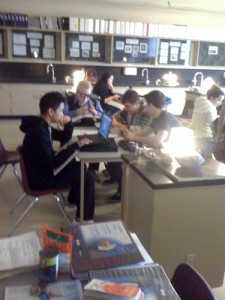We a country, province and region worry about productivity. Part of this is making sure that as many people as possible follow their passions. Here is Part 2 of the Aldergrove Secondary School design thinking story.
After the introductory exercise, Mike started the class on another project — aligning with the Planning 10/Graduate Transitions curriculum. Thought his voice was the best one to tell the story.
First we watched one clip from “Road Trip Nation.” This got the students thinking about what they wanted to be when they grew up, though most said they were not sure as to their answer. I wrote the prompt on the board, ‘how can we help students find a career?’ After some discussion and reflection, we decided to change it from ‘career’ to ‘passion.’ Then they were to start the Empathy stage.
We watched a few more clips from Road Trip Nation, and recorded information from the interviews of people who had found their passion. We interviewed each other, to learn more about those people who had not found their passion. Then I kind of just flew by the seat of my pants for the rest of the process. Was the question too narrow or broad? Should we have only interviewed one group (without a passion, for example) ? We recorded our information on post-its, and placed it on a large piece of paper that is organized into the four quadrants.
At this point, the students were still excited, and began calling people from all over to interview those who felt they were living their passion, and also those that were not. They called people in the community, those from prominent businesses, and even all the way in LA and Texas (thanks Google phone!). We covered phone etiquette, and encouraged students to be confident to call whoever they wished. It was inspiring to see the students building skills and confidence.
The class developed a “Point of View” statement to work with: 
“A student who is afraid of failing needs the confidence to follow her passion, because money will not make her feel whole, following her purpose will.”
Mike commented in his notes to me that this was perhaps a tough problem to take on for the first go at design thinking. I think he is right — it is not as concrete as trying to develop a product or improve/develop some sort of service, e.g. the car maintenance experience.
That being said Mike and the class didn’t give up — they began gathering inspiration and ideas began developing. But they ran into the problem that most of us do: the falling in love with the idea.
Several ideas were developed, but only a few groups came up with more than one or two ideas. They seemed to get fixated on one idea, and it was hard work to get them to think outside the box. This makes sense, since they have been taught the opposite for the last ten years of their education! I purchased a book on journalling that I think will help free them up and help them to not worry about being “wrong” (“Mess: the manual of accidents and mistakes,” by Keri Smith).
The project is on-going and I think it is wonderful the way Mike and his students (26 of them) are willing to accept the fact that there isn’t a perfect and correct path or process to get to a solution or a set of solutions.
Final word from Mike:
It is an experiment, and as such has been less than perfect. As teachers, we are often afraid to try new ideas, and possibly fail. Design thinking has forced me to act how I want the students to act, and so I experimented, fumbled, and learned. If there is anything I that I think will be valuable to share, it is that I have never seen students so engaged, have never utilized a pedagogy that required the use of and also fostered the growth of so many skills that are essential for success.
I am going to ask some of the d.studio alumni if they would like to visit Mike’s class. Could be fun.